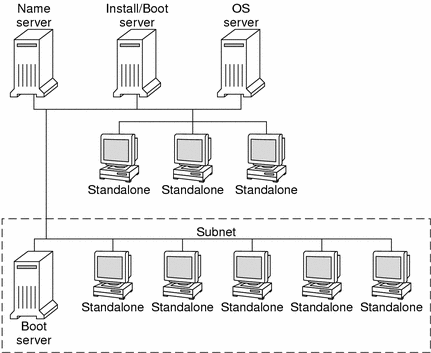Preparing to Install From the Network (Overview)
This chapter provides an introduction on how to set up your network and systems to install the Solaris software from the network instead of from DVD or CD media.
Planning for a Network Installation Introduction
This section provides you with information you need before you can perform an installation from the network. Network installations enable you to install the Solaris software from a system, called an install server, that has access to the Solaris 9 disc images. You copy the contents of the Solaris 9 DVD or CD media to the install server's hard disk. Then, you can install the Solaris software from the network by using any of the Solaris installation methods.
Required Servers for Network Installation
To install the Solaris operating environment from the network, the systems to be installed require the following servers to be present on the network.
Install server - A networked system that contains the Solaris 9 disc images from which you can install Solaris 9 software on other systems on the network. You create an install server by copying the images from the following media:
Solaris 9 DVD
Solaris 9 Software 1 of 2 CD and Solaris 9 Software 2 of 2 CD
After you copy the image from the Solaris 9 Software 1 of 2 and Solaris 9 Software 2 of 2 CDs, you can also copy the images from the Solaris 9 Installation CD and the Solaris 9 Languages CD as necessary for your installation requirements.
You can enable a single install server to provide disc images for different Solaris releases by copying the images on to the install server's hard disk.
For details about how to create an install server, refer to one of the following sections.
Boot server - A server system that provides client systems on the same network subnet with the information that they need to boot in order to install the operating environment. A boot server and install server are typically the same system. However, if the system on which the Solaris 9 software is to be installed is located in a different subnet than the install server and you are not using DHCP, a boot server is required on that subnet.
Note - When using DHCP, you do not need to create a separate boot server. For more information, see "Using DHCP to Provide Network Installation Parameters".
For details about how to create a boot server, refer to one of the following sections:
(Optional) Name server - A system that manages a distributed network database, such as DNS, NIS, NIS+, or LDAP, that contains information about systems on the network.
For details about how to create a name server, refer to System Administration Guide: Naming and Directory Services.
Note - The install server and name server can be the same or different systems.
Figure 10-1 illustrates the servers that are typically used for network installation.
Figure 10-1 Network Installation Servers

Using DHCP to Provide Network Installation Parameters
When using Dynamic Host Configuration Protocol (DHCP), you do not need to create a separate boot server. After you have created the install server, you add clients to the network with the add_install_client command and the -d option. The -d option enables you to set up client systems for Solaris installation from the network by using DHCP. DHCP provides the network parameters that are necessary for installation. For information on DHCP options for installation parameters, see "Supporting Solaris Network Installation with the DHCP Service (Task Map)" in System Administration Guide: IP Services.



